
CONTINUING the same walk begun on Fulton Street, I then continued east on DeKalb Avenue, which begins at the erstwhile domed Dime Savings Bank at Albee Square and like a number of mid-Brooklyn streets, keeps on going and going, through Fort Greene, Clinton Hill, Bedford Stuyvesant, Bushwick and into Ridgewood, ending up at Woodward Avenue and Linden Hill Cemetery. I am wondering if the two DeKalb avenue stations, one a nexus of subway lines, the D, N, Q and R (only the Q and R stop there all the time, with express lines bypassing it) and the other a local station on the L Canarsie Line, are the two subway stops on the same street with the longest distance between them.
DeKalb is a name that is spelled and pronounced a number of different ways, though I suppose there is one correct way and the others are mistakes. I’ve seen it as DeKalb, De Kalb, and Dekalb on street signs; meanwhile, in New York and Illinois, it’s pronounced as spelled; Georgians dislike the “l” in the name and ignore it. (The old man, who used the subway station frequently for transfers, called it DEE-kalb.) It is named for Baron Johan DeKalb (1723-1780), an Alsatian German with a fondness for combat who joined the French army and made himself a baron when told only noblemen could be officers. He participated in the French and Indian War of the mid-1700s and found his way into the good graces of the Marquis de Lafayette and traveled with him to aid Americans battling for independence. He fought with Washington at Valley Forge and then made his way south, where he was mortally wounded at the Battle of Camden in South Carolina. In this part of Brooklyn, a number of Revolutionary War figures are honored with street names. Ironically, a number of notable Germans fought on the American side during the Revolution, contrasting with the Hessian mercenaries fighting with the British, in light of the USA’s two bitter wars against German expansionism in the two World Wars of the 20th Century.
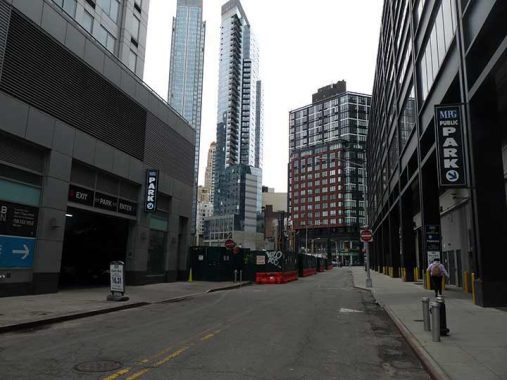
I’ll warn again that this was a leaden day in March, and because of the cloud cover, I couldn’t get photos to “pop.” I have to do all my explorations on weekends now and can’t wait for optimum weather, unfortunately. Last time I got DeKalb Avenue off with a bang with three of its greatest hits, the Dime Savings Bank, Junior’s and the Long Island University Paramount building, but this time I’ll begin with a one-block street that, to my mind, is emblematic of the urban renewal that has shaped the region for over 60 years and counting. One block of Hudson Avenue runs here, between DeKalb and Fulton, but it used to run straight north to the East River. Only this one-block piece as well as a Belgian-blocked stretch in Vinegar Hill, where it supports two restaurants, remain of Hudson Avenue’s former importance.
This piece of Hudson Avenue, believe it or not, was shadowed by an elevated train between the 1880s and 1940. The 5th Avenue El branched off from Myrtle Avenue and traveled south along Hudson Avenue, then Fulton, Flatbush and 5th Avenues to a terminal at 65th Street. It disappeared in 1940 after trying to compete with the BMT 4th Avenue Line (D, R, N) for 26 years. Want to see what Hudson Avenue looked like under the elevated? That’s doable.
A look at a 1929 street map of this area is unrecognizable today, as most streets have been paved over and forgotten. What happened? The LIU campus expanded. The Ingersoll and Farragut Houses and Brooklyn-Queens Expressway were built. The 19th Century was all about “overbuilding” as today’s architects would argue, with little warrens and alleys chockablock with tiny residences and businesses. A French architect who styled himself Le Corbusier was very influential and got the ear of traffic and parks czar Robert Moses. He waved his figurative wand, swept away all the complexity, and with his American acolytes built towers in the park, with Moses adding expressways to get people around and past them. Hudson Avenue and its elevated and companion byways were consigned to the rubbish bin.

The offices of the Benziger Brothers at #94 DeKalb at Rockwell Place have escaped is exactly the type of solid, red brick building I have always admired, and I remember the Benziger name on a couple of levels.
According to the Indispensable Walter Grutchfield, the Benziger name is in NYC because of Charles and Nicholas Benziger, German Catholics who immigrated to the States from Switzerland in the early 1800s. They published religious books and printed color religious pictures for funerals, weddings and other worship activities. Nicholas Benziger opened offices in NYC in 1853. It was Nicholas’ son, Louis, who made Benziger Brothers the largest publisher of Catholic books in the country in the 1890s, and he lived for many years in New Brighton, Staten Island.
Benziger Brothers occupied a number of offices in Manhattan until the company was acquired by Crowell Collier Macmillan in 1968. However, there’s still a sizable Benziger presence around town. The Brooklyn factory, shown above, was built in 1895 and remained in service until 1961; it has been subdivided into apartments. Benziger mansions can be found in such disparate areas as New Brighton, Staten Island and Sugar Hill in Harlem.
The Brooklyn Hospital Center occupies several acres between DeKalb Avenue and Willoughby Street east of Ashland Place. The hospital is about as old as Manhattan’s Bellevue, as it was founded in 1845. It has expanded considerably since that time, though several older buildings such as the dispensary on Ashland Place remain. The hospital was adjacent to the infamous Raymond Street Jail, famed for its harsh conditions and razed in 1963 with its acreage annexed to the hospital.
Wide Ashland Place runs from the Williamsburgh Bank Building at Flatbush Avenue and Hanson Place north to Myrtle Avenue and Navy Street. Its former name was Raymond Street; perhaps the name was changed so that memories of the now-vanished Raymond Street Jail, which stood at the SE corner of Ashland Place and Willoughby from 1838-1963, could be expunged.
The Brooklyn City Prison, as it was then known, was not taken over officially by the Department of Correction until January 1, 1908 and in the Official Report for the Department of Correction for 1908, we find the following description of the institution at the time:
Males were confined in dark, smelling cells with no light whatever, except that furnished from a flicker of a candle, a luxury to be enjoyed by those who had the means to procure this and at an exorbitant price. The odor arising from the cells was almost unbearable.In the female’s prison, some eighty years ago, the conditions were largely the same. [History of Detention in Brooklyn]
When you stand at DeKalb Avenue and Ashland Place, you can look south and see the Williamsburg Bank Tower (still, to me, the King of All Brooklyn Buildings) and then face north for a glimpse of the King of All Buildings itself.
Brooklyn Tech

In March 2022 Brooklyn Tech was completely wrapped in construction netting, seemingly meant to repulse the Forgotten New York camera. No matter, I’ll fish into my archives and produce this picture from 2017, when there wasn’t nearly as much repair work going on.
Brooklyn Technical High School opened in 1922 at 49 Flatbush Avenue Extension (near Fulton Street) in a converted warehouse. It moved to its present building, a 12-story structure at 28 Fort Greene Place, in 1933. It’s one of NYC’s marvels you don’t read or hear much about.
Brooklyn Tech features an Olympic-size swimming pool; foundry; a materials testing lab; an aeronautical lab; an 18,000-watt radio transmitter (and a 456-ft transmitter tower, when combined with the building’s 145-ft. height, made Brooklyn Tech the tallest combined structure in Brooklyn until recently); the 3,000 seat auditorium; and a robotics lab. It is considered one of NYC’s most elite and toughest-to-get-into high schools.
Alumni include Harry Chapin, the late storytelling pop singer; boutonniere-wearing US Congressman Gary Ackerman; ex-Congressman and sex offender Anthony Weiner; computer magnate Charles Wang; author Richard Matheson of “I Am Legend” fame; and my cousin, Jim King.
Exterior bas-reliefs depict Thomas Edison; the Wright Brothers; the father and son Roeblings who built the Brooklyn Bridge; steamship pioneer Robert Fulton; Lee De Forest, father of talking pictures; Ira Remsen, the developer of saccharin; Elmer Ambrose Sperry, inventor of the marine gyrostabilizer and the gyrocompass; and others. They all seem to be glowering on the passerby and the sculptor seemed to be implying that these were much smarter and more important people than you could ever hope to be.

As mentioned above, the radio tower surmounting Brooklyn Tech claimed title as Brooklyn’s tallest human-built structure for many years, as it was taller than the Williamsburg Tower, but it has since been surpassed by a flock of usurpers.

This buff brick building with the corner turret at DeKalb Avenue and Ashland Place is west of the Fort Greene historic district and therefore is subject to demolition by developers, but it is representative of residential-commercial architecture around 1900, give or take a few years.

#124 DeKalb Avenue just west of Fort Greene Place is the former Engine Company 257 and was also rented by filmmaker Spike Lee as a production studio. Though he moved away long ago, Lee has famously decried the region’s gentrification. The building is now residential apartments that sell in the millions, as they enjoy a view of Fort Greene Park across DeKalb Avenue; interiors can be seen here.
Fort Greene Park

Walt Whitman, editing the Brooklyn Daily Eagle from 1846 to 1848, pressed for a public park in the area where he lived in Clinton Hill, and in 1847, Washington Park, named for the President, began development. Whitman lived nearby, at 99 Ryerson Street in a building that is still standing, and it’s not surprising he wanted a park near his home.
Washington Park was partially designed by Frederick Law Olmsted and Calvert Vaux, the architects who went on to develop Central and Prospect Parks. It was constructed beginning in 1847, officially opened in 1850, and redesigned in 1867 by Olmsted and Vaux; in 1897 the park was renamed for Fort Greene, the environs of which by then had become a handsome residential neighborhood. The two-block stretch of Cumberland Street lining Fort Greene Park’s eastern side is still called Washington Park.
During the Revolutionary War, the British anchored eleven prison ships in Wallabout Bay (the body of water west of Williamsburg) and subjected American prisoners of war to deprivations and torture during the years 1776-1783. More than 11,000 died in the ships.
There were early monuments to those who became known as the “prison ship martyrs”: some of the remains were buried in the vicinity of the Navy Yard in 1808 and interred in Washington Park in 1873. The current monument, a 148-ft. Doric column, was designed by McKim, Mead and White (the firm that would later design Pennsylvania Station) and dedicated by William Howard Taft, then President Teddy Roosevelt’s Secretary of War, in 1908. The monument originally featured a staircase and elevator to its summit, where there was a lighted brasier and observation deck. The elevator was broken by the 1930s and was finally removed in the 1970s. The Prison Ship Martyrs Monument, however, remains one of Brooklyn’s more striking landmarks, visible from any part of the neighborhood. The remains of the prison ship martyrs are interred under the monument.

A group of buildings at #178-186 DeKalb between Cumberland Street and Carlton Avenue. #178 on the right is particularly interesting for its detail on the ground floor, roofline and windows, rather obscured from across the street by the gutter shed.
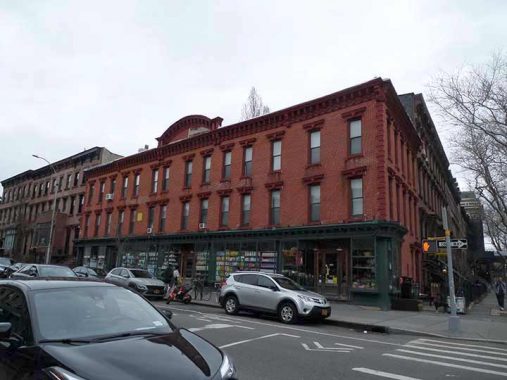
A lengthy building such as #230-238 DeKalb Avenue at Clermont is known in other locales as a “block” but that term seems to have dropped out of favor in NYC. It was designed in the centennial year of 1876 by the Parfitt Brothers architects and then as now, had stores on the bottom floor and apartments above.

It would appear that every commercial brand of potato chip is available on the grocery store on the ground floor.
Store signage on DeKalb Avenue between Clermont and Vanderbilt. I liked the simple Futura Bold font on the drugstore sign. The Roman’s sign is inscrutable, giving no indication on what is found inside: an Italian restaurant.

A group that may be considered “classic Brooklyn brownstones” from #250-258 DeKalb Avenue at Vanderbilt, constructed in 1879. That 2010s innovation, a CitiBike station, can be found in the roadbed outside the frontage. Another item that would not be found in 1879 is the pho shop on the corner.

DeKalb Avenue changes direction to the northeast a bit at Clinton Avenue, well within the Clinton Hill historic district. #275 Clinton gives just a glimpse of the handsome buildings found in the area.
The building, designed in 1897 by owner/architect Edward Betts, was one of the first luxury apartment houses in this area of Brooklyn and it replaced the ‘ large mansion of Joseph Fahys, owner of Joseph Fahys & Co., watch case manufacturers. Deed records show that Betts lost his mortgage on the building in 1898, so other people must have completed the building. Designed in an E-plan, the building originally contained thirty apartments — two per floor in each wing. [LPC Report]
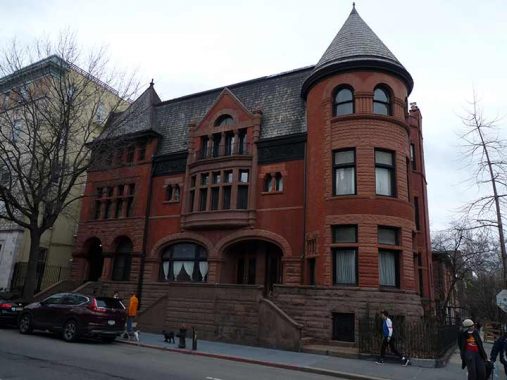
A block away at Waverly Avenue there’s #285-289 DeKalb, one of the more fantastical creations of architect Montrose W. Morris in 1889. Let Troy-based architecture columnist Suzanne Spellen, who has written under the pen name Montrose Morris, provide some context.
Morris places his large pedimented roof across the center houses and then anchors the group with the corner towers and turrets. On the top floor under the pediments is his signature colonnade of deeply set arched windows, not quite forming a loggia, one of Morris’ favorite devices. A great deal of the Morris repertoire is here: the carved bandcourses under the colonnade, and on the towers, the carved Byzantine leaf trim, the mixture of building materials: in this case rough cut and smooth brownstone, an interesting use of shingles and roofing materials, and a generous use of stained glass. Morris also loved his running collonettes: those halved mini-columns that run across the entire set of houses on the parlor floor level. Take a look at the close-ups of the details, the beauty of the carved ornament, and the little extras such as the carved faces. This is a great group of houses. [Brownstoner]
When I see beautiful buildings, I appreciate to a greater degree the building in which I live, though it’s completely different: a boxy brick building in a garden apartment complex in Little Neck; but they knew how to do them right in 1941, when it was built.

It may look like one building but this is actually a row of attached buildings from #282 to 290 DeKalb directly across the street, also designed by Morris a year later in 1890. It is faced with rock-faced and smooth-faced stone and uses such popular Romanesque Revival forms as round arches, towers, stained glass, dwarf columns, and stone transoms.
Waverly Avenue, originally named Hamilton Street, was primarily developed as a service street for the mansions on Clinton and Washington Avenues. Many of the nineteenth-century carriage houses originally built on the street survive, as do some
modest Italianate, French Second Empire, and neo-Grec style rowhouses. Here are a sampler of some of the former stables which have been readapted as residences. Like Waverly Place in Greenwich Village, it may be named after Sir Walter Scott‘s 1814 novel Waverley.
I can’t call #301-305 Washington Avenue at the corner of DeKalb a masterpiece because so many of the buildings in Clinton Hill are. Like the group at #282-290 DeKalb this is an amalgam of three buildings designed in the eclectic Queen Anne style to look to the eye as a single structure.
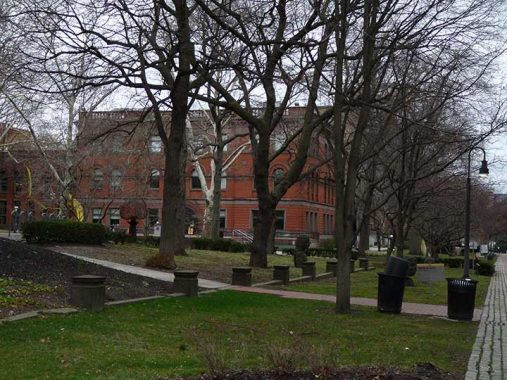
Charles Pratt, the founder of Astral Oil, made his fortune in kerosene and founded the prestigious art school, nearby Pratt Institute. Pratt built four homes in Clinton Hill as wedding gifts to his first four sons, Charles Millard, Frederic, George and Harold. Three remain standing: 229 Clinton, Fred’s place; Charles Millard’s place next door, 241 Clinton, now the residence of the Bishop of Brooklyn; and George’s on 245 Clinton, now St. Joseph College.
I have wandered onto the campus before, but today I didn’t feel like hassling with the guard at the entrance and instead got this photo of the Institute’s library. It’s quite ironic that it’s off limits this way, since Charles Pratt founded the Pratt Institute Free Library as the very first free library in Brooklyn in the 1880s: at the time, all other libraries charged admission fees. Pratt opened two branches, one in the Astral Apartments in Greenpoint (where Mae West was born, according to legend). By the time the present building was designed by Brooklyn’s William Tubby in 1896, the library numbered fully 61,000 volumes. It became restricted to Pratt students, faculty and management in 1941. The new library was innovative in every respect. It featured telephones, electric book lifts, electroplated copper bookends and glass stacks, stairs and glass floors! The library is full of arches, both in and out. The staircases are marble; there are plenty of skylights admitting natural light. I got these photos from an Open House New York tour in Clinton Hill in 2004.

The Thrift, one of Pratt’s many academic halls. Students can reside on campus if they want to do so. Surprisingly enough, only a few buildings on campus are landmarked, the library being one.
As this 1929 map shows, Pratt Institute wasn’t always a parklike campus. All north-south streets went straight through. Ryerson Street exists as a pedestrian campus path.
Grand Avenue is vouchsafed a street sign even though it hasn’t existed in this position in decades. That’s because it has some former importance, as it supported Brooklyn’s Lexington Avenue El until 1950. The el branched from Myrtle, ran down Grand, turned east on Lexington and joined the Jamaica El at Broadway until it was closed and demolished in 1950. Subsequently, other north-south streets were closed and Pratt became a true campus.

Two stolid brick factories face off across DeKalb Avenue at Pratt. #369 is described as originally the Goodwill Building and that’s as much info that is available in my resources…

However, across the street is #372, now Clinton Mews luxury housing. My handy 1929 map identifies it as the Julius Grossman shoe factory. Here’s a photo from the fab 50s when it was still a factory. Here is a pair of Grossmans from the 1930s.

In the 1960s the Transit Authority posed these minuscule bus route maps at bus stops that were fairly hard to find. So hard to find, in fact, that several of them can still be seen around town as the MTA fails to remove them. As shown here, the B38 takes pretty much the same route today on DeKalb and Lafayette Avenues.

Lafayette Gardens: On April 1, 1959, the City of New York acquired the property on which the houses and playground lie and immediately transferred jurisdiction to the Housing Authority. In 1962, the Housing Authority completed the 880-unit housing complex, which is bounded by DeKalb, Franklin, Lafayette, and Classon Avenues.

Directly across from Lafayette Gardens at #298 Classon Avernue at DeKalb is the Romanesque 4th (later 88th) Police Precinct built with its distinctive tower in 1890, which was a great era for architecture. It was designed by George Ingram, who wound up designing quite a number of classic police precincts scattered across Brooklyn. He preferred to think of police precincts as fortresses or castles.
Lengthy Kent Avenue begins at DeKalb Avenue; actually until 1959 it extended one block further south to Lafayette before Lafayette Gardens was built. Both Kent Avenue and the much shorter Kent Street in Greenpoint are named for James Kent, the first law professor at Columbia University.
I recently walked nearly its entire length, as I had done a decade previously, but that will wait for another day. Why? I Kent explain….
As always, “comment…as you see fit.” I earn a small payment when you click on any ad on the site.
5/1/22





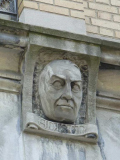



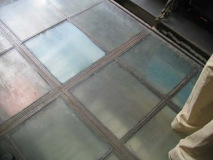




17 comments
I think the distance between the Atlantic Ave subway station complex of nine different lines and the Atlantic Ave station on the L are farther in distance than the two DeKalb Ave statiins
Brooklyn Tech used to have the coolest school mascot: an Ed Norton
looking civil engineer squinting through a surveyor’s transit but was
outlawed for being politically incorrect and hurting people’s feelings
Shame on you, Brooklyn Tech for treating Ed Norton like this:
https://www.bing.com/videos/search?q=the+honeymooners+ed+norton&docid=608054132596615249&mid=1671C125D37233C9E3E91671C125D37233C9E3E9&view=detail&FORM=VIRE
When political correctness comes after Ed Norton, nobody is safe from the lunacy.
And of course, Ralph himself once purchased a nifty vacuum cleaner for $4.95 down at the quite fictional Dauser’s on DeKalb Avenue……….(turned out it needed a “touch of erl” however…..
The B train also stops at the DeKalb Ave station on the 4th Ave line, except overnight and weekends when it does not run.
I lived on South Oxford St for one year and Clinton and DeKalb for eight. I always longed to see this once elegant neighborhood brought back, now that it is, be careful what you wish for. High rents and tons of car traffic.
Couple of things:
(1) With regard to two subway stops on the same street with the longest distance between them, there are two other candidates in Queens. Woodhaven Blvd. is on both the R and M at Queens Blvd., and the J and Z at Jamaica Ave. 111th Street is on the #7 near Citi Field and the A train at Liberty Avenue, with a stop at Jamaica Ave. located in between.
(2) The 5th Avenue El didn’t exactly compete with the BMT 4th Avenue Line (D, R, N) for 26 years, because both were BMT (prior to 1923, BRT) properties. The newer subway route, opened in 1915, basically supplanted the earlier 19th century elevated route by providing direct service to any Manhattan location south of 60th Street. The older elevated route, by contrast, only went as far as the Park Row terminal at the Brooklyn Bridge’s Manhattan landing. By about 1920 the 5th Avenue El branch between 38th and 65th Streets, atop 3rd Avenue, was relegated to a single car shuttle because the parallel 4th Avenue subway had sucked away most ridership. When New York City’s Board of Transportation too over the BMT on June 1, 1940, the entire 5th Avenue El was closed because of its redundancy and low ridership.
I believe the photo of Behrens Pharmacy is the same corner I remember when we lived at 129 Clermont in the early 60’s. If I’m not mistaken, that used to be a bar. With the Cadillac’s and Lincoln’s parked out front, that was probably one of the safest neighborhoods in Brooklyn. There was a fruit stand across the street from the bar my father worked at, a candy store down the street owned by my friend’s grandfather and Laru’s grocery store on Adelphi Street that most in the neighborhood shopped at.
Thank you for the pleasant memory.
My mistake! Wrong corner. It looked like the corner of Myrtle and Cleremont. I should have read the narrative closer.
I’m from the Class of ’78. The machine, aero, wood and foundry shops, plus the Material Sciences Department, were eliminated in the ’80s and ’90s. Lee McCaskill was the worst person to hold the position of principal in Tech. His ill-conceived policies almost destroyed the school’s reputation as one of the elite high schools.
“Why streets are not named for their honorees during their lifetimes when they can bask in the glory is an exercise for the reader.”
Local Community boards, for the most part, adhere to a ridiculous policy of not naming streets after living people. I tried to get the running oval in McCarren Park
renamed in honor of local resident. and two-time Olympian (’52 Helsinki and ”56 Tokyo) Constance Darnowski-Stoll. CB 1 informed me of the policy and added that they wouldn’t consider it until five years after she died.
I wasn’t enough of a nerd to get into Tech, so I went to New Utrecht instead. I took my SAT’s in December 1963 at the Adelphi Academy in Fort Greene, a few blocks from the “G” train. Even in the mid-morning that was a sketchy neighborhood and I didn’t want to find out what it looked like after dark. But I also wanted to get a good score, so I took my time until 5 PM. It’s a good thing it was cold and the locals weren’t out and about, but you can bet I did a bit of speed walking back to the subway! I think Adelphi has since moved to Bay Ridge.
Adelphi Academy’s building was sold to Pratt Institute later in the 1960s. When I began graduate study at Pratt in September 1969 the Adelphi building had become Pratt’s Higgins Hall, headquarters for the architecture and urban planning programs (I received a master’s degree in the latter). Virtually all of my classes when I attended Pratt 1969-73 were in that building, so I rarely ventured onto the main campus a block away. Since I was working full time and attending Pratt at night, I agree with your assessment that the area was a bit dicey in those days. I simply arrived for my classes 1 or 2 nights per week, parked my car, and then split at the end. Being already married, my socializing there was limited to my fellow urban planning students.
Many years later, in July 1996, a fire destroyed much of Higgins Hall, which was built in 1868. It has been rebuilt and the newer version is still a Pratt facility.
The only place I and fellow students would hang out before a class was at Mike’s Coffee Shop, a traditional NYC style luncheonette run by a Greek man, at the corner of St. James Place and DeKalb Ave. Amazingly, it’s still there, according to Google Street (at least it was in 2020).
Actually I dont know why Brooklyn Tech doesnt use that mascot anymore.I was being
a little sarcastic in order to make a point because after all,isnt that the usual reason they
always give in those situations?
Chris, maybe because Brooklyn Tech is now co-ed? When I went (Class of 68) it was exclusively male.
I’m Brooklyn Tech Class of 1968. I remember the swimming pool and the foundry. As a complement to Foundry class (one messy class having to make the molds), we also had a Pattern Making class where we made the patterns to place in the molds in the foundry.